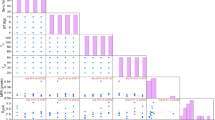Abstract
Present study describes the approach of applying response surface methodology (RSM) with a Pareto-based multi-objective genetic algorithm to assist engineers in optimization of sheet metal forming. In many studies, finite element analysis and optimization technique have been integrated to solve the optimal process parameters of sheet metal forming by transforming multi-objective problem into a single-objective problem. This paper aims to minimize objective functions of fracture and wrinkle simultaneously. Design variables are blank-holding force and draw-bead geometrical parameters (length and diameter). RSM has been used for design of experiment and finding relationship between variables and objective functions. Forming limit diagram has been used to define objective functions. Finite element analysis applied for simulating the process. Proposed approach has been investigated on a fuel tank drawing part and it has been observed that it is more effective and accurate than traditional finite element analysis method and the “trial and error” procedure.










Similar content being viewed by others
References
A. Makinouchi, Sheet metal forming simulation in industry. J. Mater. Process. Technol. 60, 19–26 (1996)
T. Ohata, Y. Nakamura, T. Katayama, E. Nakamachi, K. Nakano, Development of optimum process design system by numerical simulation. J. Mater. Process. Technol. 60, 543–548 (1996)
Y.Q. Guo, J.L. Batoz, H. Naceur, S. Bouabdallah, F. Mercier, O. Barlet, Recent developments on the analysis and optimum design of sheet metal forming parts using a simplified inverse approach. Comput. Struct. 78, 133–148 (2000)
H. Naceur, Y.Q. Guo, J.L. Batoz, C. Knopf-Lenoir, Optimization of drawbead restraining forces and drawbead design in sheet metal forming process. Int. J. Mech. Sci. 43, 2407–2434 (2001)
O. Kayabasi, B. Ekici, Automated design methodology for automobile side panel die using an effective optimization approach. Mater. Des. 28, 2665–2672 (2007)
L. Chen, J.C. Yang, L.W. Zhang, S.Y. Yuan, Finite element simulation and model optimization of blankholder gap and shell element type in the stamping of a washing-trough. J. Mater. Process. Technol. 182, 637–643 (2007)
M. Azaouzi, H. Naceur, A. Delameziere, J.L. Batoz, S. Belouettar, An heuristic optimization algorithm for the blank shape design of high precision metallic parts obtained by a particular stamping process. Finite Eleme. Anal. Des. 44, 842–850 (2008)
Kh. Khalili, P. Kahhal, E. Efthekhari Shahri, M.S. Khalili, Blank optimization in elliptical-shaped sheet metal forming using response surface model coupled by reduced basis technique and finite element analysis. Key Eng. Mater. 473, 683–690 (2011)
Y. Huang, Z.Y. Lo, R. Du, Minimization of the thickness variation in multi-step sheet metal stamping. J. Mater. Process. Technol. 177, 84–86 (2006)
T. Ohata, Y. Nakamura, T. Katayama, E. Nakamachi, Development of optimum process design system for sheet fabrication using response surface method. J. Mater. Process. Technol. 143–144, 667–672 (2003)
W. Hu, L.G. Yao, Z.Z. Hua, Optimization of sheet metal forming processes by adaptive response surface based on intelligent sampling method. J. Mater. Process. Technol. 197, 77–88 (2008)
T. Jansson, L. Nilsson, Optimizing sheet metal forming processes—using a design hierarchy and response surface methodology. J. Mater. Process. Technol. 178, 218–233 (2006)
T. Jansson, A. Andersson, L. Nilsson, Optimization of draw-in for an automotive sheet metal part: an evaluation using surrogate models and response surfaces. J. Mater. Process. Technol. 159, 426–434 (2005)
S. Guangyong, L. Guangyao, G. Zhihui, C. Xiangyang, Y. Xujing, L. Qing, Multiobjective robust optimization method for drawbead design in sheet metal forming. Mater. Des. 31, 1917–1929 (2010)
A. Konak, D.W. Coit, A.E. Smith, Multi-objective optimization using genetic algorithms: a tutorial. Reliab. Eng. Syst. Saf. 91, 992–1007 (2006)
A. Farhang-Mehr, S. Azarm, Entropy-based multi-objective genetic algorithm for design optimization. Struct. Multidiscipl. Optim. 24, 351–361 (2002)
T. Hiroyasu, M. Miki, J. Kamiura, S. Watanabe, H. Hiroyasu, Multi-objective optimization of diesel engine emissions and fuel economy using genetic algorithms and phenomenological model. SAE paper no. 2002-01-2778 (2002)
E.M. Kasprzak, K.E. Lewis, Pareto analysis in multiobjective optimization using the collinearity theorem and scaling method. Struct. Multidiscipl. Optim. 22, 208–218 (2001)
W. Liu, Y. Yang, Multi-objective optimization of sheet metal forming process using Pareto-based genetic algorithm. J. Mater. Process. Technol. 208, 499–506 (2008)
W.F. Hosford, R.M. Caddel, Metal Forming Mechanics and Metallurgy (Cambridge University Press, Cambridge, 2007), Chap. 15, pp. 241–244
Author information
Authors and Affiliations
Corresponding author
Rights and permissions
About this article
Cite this article
Kahhal, P., Brooghani, S.Y.A. & Azodi, H.D. Multi-objective Optimization of Sheet Metal Forming Die Using Genetic Algorithm Coupled with RSM and FEA. J Fail. Anal. and Preven. 13, 771–778 (2013). https://doi.org/10.1007/s11668-013-9747-5
Received:
Revised:
Published:
Issue Date:
DOI: https://doi.org/10.1007/s11668-013-9747-5



